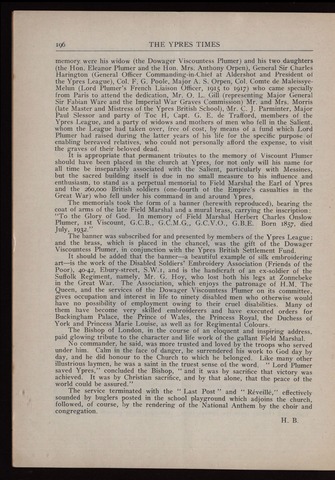iq6
THE YPRES TIMES
memory were his widow (the Dowager Viscountess Plumer) and his two daughters
(the Hon. Eleanor Plumer and the Hon. Mrs. Anthony Orpen), General Sir Charles
Harington (General Officer Commanding-in-Chief at Aldershot and President ot
the Ypres League), Col. F. G. Poole, Major A. S. Orpen, Col. Comte de Maleissye-
Melun (Lord Plumer's French Liaison Officer, 1915 to 1917) who came specially
from Paris to attend the dedication, Mr. O. L. Gill (representing Major General
Sir Fabian Ware and the Imperial War Graves Commission) Mr. and Mrs. Morris
(late Master and Mistress of the Ypres British School), Mr. C. J. Parminter, Major
Paul Slessor and party of Toe H, Capt. G. E. de Trafford, members of the
Ypres League, and a party of widows and mothers of men who fell in the Salient,
whom the League had taken over, free of cost, by means of a fund which Lord
Plumer had raised during the latter years of his life for the specific purpose of
enabling bereaved relatives, who could not personally afford the expense, to visit
the graves of their beloved dead.
It is appropriate that permanent tributes to the memory of Viscount Plumer
should have been placed in the church at Ypres, for not only will his name for
all time be inseparably associated with the Salient, particularly with Messines,
but the sacred building itself is due in no small measure to his influence and
enthusiasm, to stand as a perpetual memorial to Field Marshal the Earl of Ypres
and the 260,000 British soldiers (one-fourth of the Empire's casualties in the
Great War) who fell under his command in and around Ypres.
The memorials took the form of a banner (herewith reproduced), bearing the
coat of arms of the late Field Marshal and a mural brass, carrying the inscription
"To the Glory of God. In memory of Field Marshal Herbert Charles Onslow
Plumer, 1st Viscount, G.C.B., G.C.M.G., G.C.V.O., G.B.E. Born 1857, died
July, I932
The banner was subscribed for and presented by members of the Ypres League:
and the brass, which is placed in the chancel, was the gift of the Dowager
Viscountess Plumer, in conjunction with the Ypres British Settlement Fund.
It should be added that the bannera beautiful example of silk embroidering
artis the work of the Disabled Soldiers' Embroidery Association (Friends of the
Poor), 40-42, Ebury-street, S.W.i, and is the handicraft of an ex-soldier of the
Suffolk Regiment, namely, Mr. G. Hoy, who lost both his legs at Zonnebeke
in the Great War. The Association, which enjoys the patronage of H.M. The
Queen, and the services of the Dowager Viscountess Plumer on its committee,
gives occupation and interest in life to ninety disabled men who otherwise would
have no possibility of employment owing to their cruel disabilities. Many of
them have become very skilled embroiderers and have executed orders for
Buckingham Palace, the Prince of Wales, the Princess Royal, the Duchess of
York and Princess Marie Louise, as well as for Regimental Colours.
The Bishop of London, in the course of an eloquent and inspiring address,
paid glowing tribute to the character and life work of the gallant Field Marshal.
No commander, he said, was more trusted and loved by the troops who served
under him. Calm in the face of danger, he surrendered his work to God day by
day, and he did honour to the Church to which he belonged. Like many other
illustrious laymen, he was a saint in the truest sense of the word. Lord Plumer
saved Ypres," concluded the Bishop, and it was by sacrifice that victory was
achieved. It was by Christian sacrifice, and by that alone, that the peace óf the
world could be assured."
The service terminated with the Last Post and Réveillé," effectively
sounded by buglers posted in the school playground which adjoins the church,
followed, of course, by the rendering of the National Anthem by the choir and
congregation.
H. B.

